SUBJECTS
GRADE
Show Results
'Shape' Perspective Through the Hoop Dance

Lesson Summary
- Explore information and show respect for the Hoop Dance.
- Look at shapes in abstract art and create art with pattern blocks.
- Print shapes with paint to tell a story.
- Demonstrate respect for others while sharing personal artwork in groups.
Lesson Plan and Procedure
Lesson Key Facts
- Grade(s): K, 1, 2, 3, 4, 5, 6
- Subject(s): Health, Math, Social Studies, Visual Arts, Native American
- Duration of lesson: Two sessions, 50 minutes each
- Author(s): Terry Goedel, Rachel Gonthier, and Mary Grace Johnson
This lesson was developed in collaboration with several Native Hoop Dancers including Michael Goedel, Terry Goedel, Patrick Willie, Meredith Little, and Kelina Anderson. While no one is certain which tribe originated hoop dancing, it has become an intertribal dance, meaning different tribes now do it across regions. However, we have still tried to share the individual tribal aspects of the dance where possible, reinforcing that there are many different Native tribes across North America, not just one Native American group. We hope that others will respect these Hoop Dancers’ choice to share this aspect of their culture.
There is additional background information available for teachers about:
- Who Can Hoop Dance
- What is Needed to Hoop Dance
- The Symbolism in the Hoop Dance
- History and Evolution of the Hoop Dance
Section One: Discover Hoop Dance
(10 minutes)
Teacher: We are going to watch a video of someone dancing. The dancer will be using hoops and his body combined to form different things. See if you can identify any objects he creates during the dance.
Watch the Hoop Dance video. (3:30) Also on slide 4.
Teacher: What thoughts do you have after watching the dance? Everyone stand up and show me with your hands and arms what kinds of objects you saw in the video.
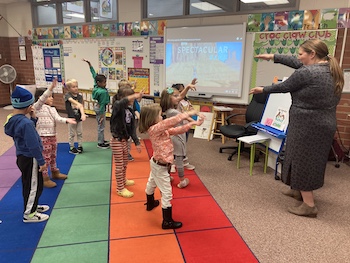
Have students take turns showing and explaining different objects they saw in the dance. Have the whole class copy the student’s motion before having the next student share. For example: make a crocodile mouth by moving your arms together.
Teacher: This dance tells a story. Do you have any guesses about what the story might be about?
After students have shared their thoughts, share the following video of a Hoop Dancer explaining a bit about the story of the Hoop Dance and some of the objects represented in the video. (1:38) Also on slide 5.
Use slides 6-9 to illustrate some of the things that Terry Goedel points out in the video.
Shapes Can Tell a Story
(10 minutes)
Teacher: Now that you know more about the objects shown in the dance and the story that they tell, let’s watch it one more time and look for some of the animals and things that Terry taught us about.
Watch the Hoop Dance video again and discuss. (3:30)
Teacher: Like Hoop Dancers, many visual artists use shapes to tell a story with their artwork. When shapes are put together to represent something and it doesn’t look realistic, we use the word “abstract” to describe them. Abstract art is a type of art that doesn’t try to show things as they are in real life, but instead uses shapes, forms, colors, and lines to represent them differently. Abstract art usually shows how an artist thinks or feels rather than what he or she sees. Here are some examples of abstract art:
Show slides 12-23 in the presentation with examples of abstract art and compare them with images from real life. Ask students to point out ways the artworks use shape, line, and color in ways that are different from real life.
Shape Compositions
(30 minutes)
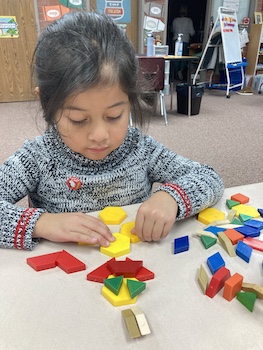
Teacher: Now we are going to experiment with making images out of shapes! You will be composing your own artwork out of shapes using pattern blocks. Will it be an animal, a person or a thing? What story do you want to tell through your artwork? These are the shapes we are going to work with today.
Hand out pattern blocks (hexagon, triangle, square, rhombus, trapezoid etc.).
Teacher: Which shapes can you name? What new shapes can you make by combining different shapes from your set of shapes? Compose simple shapes to form larger shapes. For example, "Can you join these two triangles with full sides touching to make a rectangle?"
Spend time reinforcing geometry concepts that your class needs and then give the students time to create their artwork. You may want to explore 3-dimensional shapes using blocks or magnatiles.
After 20 minutes, take the class on a walk around the room to look at their compositions and talk about their work.
Section Two: Printmaking with Shapes
Preparation:
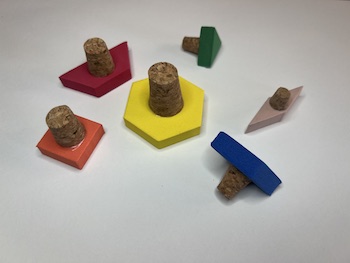
- Pour tempera paint onto only half of a plate or tray, leaving room on the other half for students to dab off excess paint.
- You might want to have smocks or some kind of messy shirt that the students can wear to protect their clothes. Most tempera paint is washable, but having smocks keeps things cleaner.
- For printing, you can use 3D foam blocks or flat foam pattern blocks with some kind of handle glued on the back (small corks work well for handles). Divide shapes into sets to be distributed to different groups of desks or tables.
- It’s easiest to have each shape be designated for one paint color. If you decide to let students dip a shape into multiple colors, have wet wipes on hand to clean off their stamp before dipping into a new color.
- You can print on white painting paper or you can also print on colorful cardstock. If different colors of paper are offered, make sure to teach the students about contrasting colors and the importance of choosing to stamp colors that will stand out from the paper and not blend in.
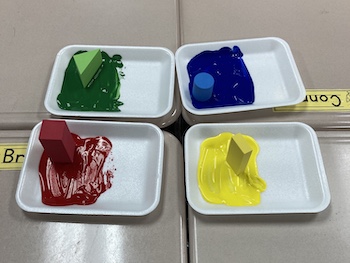
Printmaking
(30 min)
Teacher: In our previous lesson, we learned about Native American Hoop Dance and how Hoop Dancers use the shape of the hoops to represent different objects in their dance. We also learned about abstract art and how artists also use shapes and other art elements to represent things differently from real life. Today we will be making some abstract art by printing with these foam shapes. You will be stamping different shapes in paint and arranging them on your paper to tell your own story.

Divide students into groups and explain how to keep paint from cross-contaminating. Give students an extra piece of paper to practice stamping and experiment with the shapes before making their final piece.
When the prints are complete, ask students to look at their work and reflect on the similarities and differences with the Hoop Dance they saw earlier. Allow students to share their thoughts.
Showing Respect For the Hoop Dance
(5 minutes)
Display picture of Patrick Willie on slide 25.
Teacher: This is a picture of Patrick Willie. The Hoop Dance is a special dance that is only done by Native Americans. A Hoop Dancer named Patrick Willie, Navajo/Diné, said it is important to remember that “It’s not just a cool dance. It shares our [Native] history; it shares our teachings.” In fact, the Hoop Dance is so special for Native Americans that years ago, people who weren’t Native couldn’t even see the dance performed at all. It was only done as a ceremonial healing dance. Now non-Native people can watch the dance, however they shouldn’t perform it. It is important to be kind and grateful to Native people who share their dance with us. For them, performing the Hoop Dance for us is like giving us a gift. They are sharing their teachings and the healing that can come through the Hoop Dance with their audience.
Teacher: Have you ever given someone a gift that you worked hard on or was special to you? How did they react? How did their reaction make you feel?
Respecting Others as They Share Their Art and Stories
(15 minutes)
Teacher: In the same way that it is important to be kind and respectful when Hoop Dancers share their dance with us, it is also important to be kind and respectful when your friends, classmates, siblings, or others share things with you. They might share a gift, or even a story. When someone is telling you about themself or about their day, they are sharing something with you. How can we be kind and respectful in those situations?
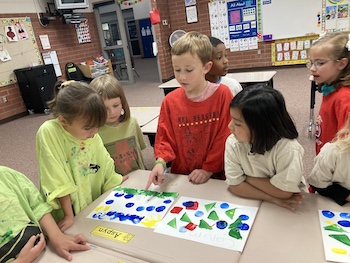
Discuss student answers. Some ideas include: listening, asking questions, looking at people while they speak, not talking while others are sharing, not laughing or rolling our eyes, or poking fun if it isn’t supposed to be funny or a joke.
Teacher: We have a chance to practice these skills right now by sharing our art work with each other!
Put students into groups or tables and have each student take a turn to talk about their artwork. Be sure to have them share which shapes they used, what picture they made, and what story is connected with their picture. As you walk around, consider commenting on the behaviors you have just discussed as a class such as complimenting students on listening, watching, and asking questions.
Learning Objectives
- Identify grade-appropriate shapes.
- Understand the story of the Hoop Dance and how shapes are used to represent the things around us and tell stories.
- Respectfully engage with others when art is being shared.
Utah State Board of Education Standards
This lesson can be used to meet standards in many grades and subject areas. We will highlight one grade’s standards to give an example of application.
Grade 1 Visual Arts
Standard 1.V.CR.2: Explore the use of materials and tools to create works of art or design; use art materials, tools, and equipment in a safe way; and identify and classify uses of everyday objects through drawings, diagrams, sculptures, or other visual means.
Standard 1.V.CR.3: Use art vocabulary to describe choices while creating art.
Standard 1.V.R.3: Classify artwork based on different reasons for preferences.
Standard 1.V.CO.2: Relate artistic ideas and works with societal, cultural, and historical context to deepen understanding that people from different times and places have made art for a variety of reasons.
Grade 1 Math
Standard 1.G.1: Distinguish between defining attributes (for example, triangles are closed and three-sided) versus non-defining attributes (for example, color, orientation, overall size); build and draw shapes that possess defining attributes.
Standard 1.G.2
a. Compose two-dimensional shapes (rectangles, squares, trapezoids, triangles, half circles, and quarter-circles) to create a composite shape, and compose new shapes from the composite shape.
Grade 1 Social Studies
Standard 1.1.2: Summarize the contributions of a diverse range of historical figures and groups in their community, state, and nation, and evaluate their significance (for example, figures might be chosen based on their examples of honesty, integrity, morality, civility, duty, honor, service, respect, obedience to law).
Standard 1.1.4: Create a primary source to show how their personal histories are shaped by family, school, and community (for example, timeline, interview, artifact collection, recipe book).
Standard 1.3.5: Demonstrate characteristics of responsible citizenship (for example, respect others’ property, treat people with dignity, find solutions to conflicts, take responsibility for one’s actions, take care of school grounds).
Health Education
Standard 1.HF.3: Demonstrate how to express gratitude, treat others with kindness, and respect differences.
Equipment and Materials Needed
- BYU’s Living Legends video of Michael Goedel performing the Hoop Dance
- Video of Terry Goedel explaining the Hoop dance
- Slide presentation on Hoop Dance and Abstract Art
- Pattern blocks
- Painting paper or cardstock (80 lb. sulphite paper works well)
- Tempera paint
- Paper plates or styrofoam trays to hold paint
- 3-D foam blocks for printing or flat foam pattern blocks with cork handles glued on
- Wet wipes (helpful for cleanup)
Additional Resources
This lesson was created thanks to a grant from the National Endowment for the Arts and the Utah Division of Arts & Museums.
- Interview of Terry Goedel discussing Hoop Dancing
- A video of Natives singing and Hoop Dancing to “The Circle of Life” from The Lion King
- A video of Hoop Dancers dancing around the country in a prayer of healing from the COVID-19 pandemic
- Fact sheets regarding:
- Left Hand Bull, Jacqueline. 1999. Lakota hoop dancer. Edited by Suzanne Haldane. 1st ed. Dutton Children's Books, New York.
Image References
Image 1: Courtesy of Terry Goedel
Images 2-3: Emily Soderborg
Image 4: Rachel Gonthier
Images 5-7: Emily Soderborg

www.education.byu.edu/arts/lessons
 Download
Download